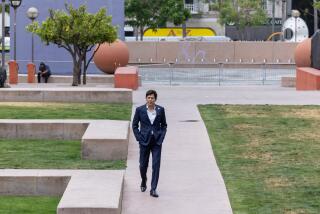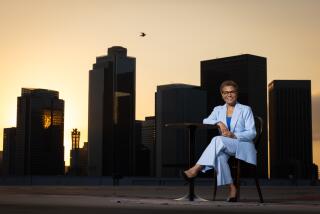‘A Great Man, a Great Leader’
- Share via
Some wore jeans, some wore satin. Some wept, others bowed their heads. On a sun-splashed October Sunday, a crowd of mourners representing Los Angeles’ breadth and diversity came to the Convention Center, the hall named in Tom Bradley’s honor, to pay their last respects to the man they knew simply as “The Mayor.”
Most came with some personal remembrance that drew them from as far away as Palm Springs to view the casket of the man who served as Los Angeles mayor for an unprecedented 20 years.
Many said they felt close enough to consider Bradley a father figure, someone whose picture stood on their mantle.
“We wish people like this would never die,” said Rafael Chavez, a utility technician who came from La Puente to release 30 doves as the doors of the hall were opened to about 200 people who had been standing in line.
Many visitors were visibly distraught, including Clovis, Calif., resident David Armstrong, 13, Bradley’s godson, and his mother, Megan Wells, who embraced as they stood in front of the casket.
Tommy Gettis, 55, who like Bradley was a sharecropper’s son, said he felt a special kinship with a man who overcame great odds to become mayor of America’s second-largest city.
Raul Aguilar, beaten at the intersection of Florence and Normandie at the outset of the 1992 Los Angeles riots, called Bradley a figure of reconciliation who helped the city come to terms with all of its parts.
Ron Frazier, a 35-year-old Marina del Rey resident, met Bradley at a gay and lesbian pride parade when he was 19 and said he discerned an integrity and tolerance that was inspiring.
Horace Staubley, a 74-year-old Carson resident, was unable to speak because of a speech impairment, but proudly held close to his heart a faded 21-year-old color snapshot of himself and Bradley shaking hands.
In all, nearly 6,000 people paid their respects to Bradley, who died Tuesday at 80. Funeral services open to the public will be held today at First AME Church. Public seating will be limited but services will be broadcast on speakers outside the church.
Inside the exhibition hall, Bradley lay in an ebony coffin draped by a spray of red roses and surrounded by white lilies. A red carpet guided the solemn procession past the remains.
On a nearby chair lay an open Bible and a folded American flag. Many of the mourners stopped to take pictures of the full-length oil painting of Bradley posed as many no doubt will always remember him: standing erect in an elegant dark suit, eminently dignified, but with the slightest hint of a smile brightening the picture.
The public viewing also attracted such dignitaries as Mayor Richard Riordan, Police Chief Bernard C. Parks, Rep. Maxine Waters (D-Los Angeles) and former U.S. Sen. John V. Tunney (D-Calif.).
Riordan walked down the red carpet to the coffin, knelt on both knees and bowed his head.
“A real emptiness went through my body when I approached the casket,” Riordan said a few minutes later. “I said, ‘Tom, you are a great man, a great leader and you left a legacy of one of the greatest cities in the world, a city united.’ ”
Testament to Ability to Build Coalitions
Scores of former Bradley staff members--many now working for senators and congressmen--came from around the country to take shifts as honor guards.
But it was a day set aside for a public that felt a strong allegiance to the man who served as their mayor for two decades.
Many were African Americans in whose community Bradley spent his formative years. But, in a testament to Bradley’s abilities as a builder of coalitions, the mourners represented a broad cross-section of the city’s ethnic and political makeup.
Harry Bey, a white Republican, came with a scrapbook filled with pictures and testaments to his lifelong cause--Project Gangs, a 30-year-old organization that was one of the first to offer services to troubled youth.
“He said, ‘Harry, this is not about politics, this is about people,’ ” Bey remembered the liberal Democrat saying. “I must have used his office a thousand times, sometimes just to send a fax. He made his door always open. He was a remarkable and unique human being.”
Many young children filed past the casket as adults explained the significance of Bradley’s life and legacy.
“My grandmother brought us because 50 years from now, we will be studying about Los Angeles, and we can say we saw him,” said Kathryn Brown, 8, after carefully signing her name in one of the guest books. “I think I learned something about history today.”
Kyle Jackson, 46, brought his three sons, Kyle Jr., 12, Kevin, 10, and Kendall, 7, to teach them about the obstacles Bradley overcame. After joining the Los Angeles Police Department, Bradley rose to the rank of lieutenant and was the highest-ranking African American in the department at the time of his retirement in 1961.
He was the first black elected to the City Council and became the first black mayor of a major California city.
“I want my sons to know about the honor and distinction with which he served this city,” said Jackson, a LAPD captain in Van Nuys. “He left a great legacy, not only as an African American, but as a great man.”
“This is the first time I’ve seen him,” his son Kevin said later. “I’m happy I got to see him. I really admire him, and when I try hard, I’ll think about him.”
Anita Robinson was 13 when Bradley mounted his first, unsuccessful run for mayor against incumbent Sam Yorty in 1969. Robinson remembered that during that campaign, her church choir provided backup vocals for singer Stevie Wonder at a rally.
“We were standing close to him and he spoke to us, but I didn’t get a chance to shake his hand,” she said. “It was just exciting. I didn’t know what a mayor’s race was then. But it turned out that he was the best mayor L.A.’s had.”
But Bradley also touched people beyond the city’s limits.
David Armstrong’s grandfather was mayor of Clovis when he met Bradley during his unsuccessful 1982 gubernatorial race, according to Bill Chandler, Bradley’s press secretary for four years.
The families stayed in touch after the campaign, and when David was born, his mother asked Bradley to be godfather.
Many remarked on Bradley’s ability to bridge the city’s divisions.
Gettis, the former sharecropper, said his relationship with Bradley began on a angry note. Gettis had become unemployed, victimized, he felt, by an uncaring city. Not knowing what else to do, he wrote the mayor to vent.
Bradley’s personal reply and encouragement began a long-standing correspondence. “We identified with each other,” said Gettis. “He was an inspiration.”
Aguilar happened to pass a flash point of the 1992 riots on his way home, when he was pulled from his car and beaten to unconsciousness by five youths and run over. He was rescued by a black couple, James and Barbara Henry, who risked their own lives to save him. They remain friends.
To Aguilar, a real estate salesman from Norwalk, Bradley epitomized the city’s ability to overcome some of its most painful wounds.
“I at least owe him the respect to come out and see him at the end,” he said.
Frazier recalled Bradley’s appearance at a gay and lesbian pride parade.
“There’s the mayor, walking through the crowd, saying hi and having the time of his life,” said Frazier. “He didn’t care what you do or who you are. He was totally open-minded. I never forgot that.”
For Horace Gardner Staubley, no words were necessary. To any and all who would look, he proudly showed the 1977 photo of his handshake, in front of a boat at the Cabrillo Marine Aquarium.
Unable to voice his sentiments, Staubley showed off his treasured picture, put his hand over his heart and sadly smiled.
More to Read
Sign up for Essential California
The most important California stories and recommendations in your inbox every morning.
You may occasionally receive promotional content from the Los Angeles Times.














